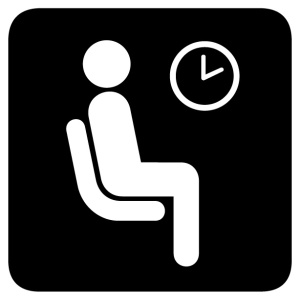The Importance of Being Patient
May 26, 2011 3 Comments
I’m not always the most patient person, and if I’m forced to wait too long for something I tend to get fidgety and frustrated. Today I learned just how important it is to take the time to step back and wait. I’m not talking about the kind of waiting we learned about in EDPSY 14 that’s necessary after you ask a question to allow the students time to think of an answer; I’m talking about sometimes sitting back and letting students start working on their own time. After reading the Corbett and Wilson article about good teaching that advocated for strict teachers, I went into my placement with the mindset of encouraging the students who were slacking off to do their work. However, my observations on Monday showed me that sometimes it is better to wait than to constantly be on the backs of students not working.
During class students often filter in whenever they feel like it, which was a hard phenomenon for me to adjust to because in my schools tardiness was dealt with severely. Furthermore, throughout the period most of them are usually talking or using their cell phones while their work is pushed off to the side. I would watch them and try to decide whether I should go over and tell them to start writing their essays, but as I waited for a few minutes the students slowly started to pull out their work on their own and started writing without any further prompting. The more I thought about it, the more I realized that what originally looked like students ignoring their work was really just their way of taking some time to “get ready” for the day and have a few moments to themselves. I don’t mean to say though that all the students only spent a few minutes doing what they wanted. Some probably only spent ten solid minutes doing any kind of work, and others would work for a little and then take breaks or keep talking, but what was important was that I had started to question why the students would come in every day and take so long to do their work. The more I examined this issue the more I was able to put myself in their shoes and see where they were coming from. 
They had been working on these papers for the past three weeks, and they were bored with the assignment and were tired of writing. Some of them just needed a mental break. As I began to think about my own writing process, I realized that oftentimes it takes me a few minutes to get started on a paper or I just won’t feel like doing it at all, and I like English! Writing is one of those tasks that everyone approaches differently, and watching these kids struggle with their writing process reminded me of how I too struggle with writing at times. At one of our small group PSU sessions Dr. Staples told us how crucial it is as a teacher to see yourself in others, and on Monday I saw firsthand how that is true. Once I started to imagine what the students’ attitudes towards writing their biography essays were, and how I would feel if I was working on the same assignment, I began to see their behavior in a different light.
Every day and every period in my placement high school is different, but the behaviors I observe can be seen in every class. From my observations I have learned that the art of waiting is a practice that gets better with time and experience. The hard part of waiting is knowing when a student’s “mental break” turns into ignoring their work, and when it’s time for you to get involved and when it’s time for you to sit back and let the situation work itself out. I’ve noticed that a lot of the students hate it when you’re “all up in their face,” and I know that it’s just the nature of teenagers in general to feel annoyed when adults are constantly telling them what to do and watching and waiting for them to do it. At the same time though, as a teacher it is my responsibility to make sure my students are learning. As I finish up this practicum experience and when I start student teaching I hope I will get more comfortable with knowing when it is time to encourage the students to do their work and when it is time to give them room and allow them to start working when they’re ready.
